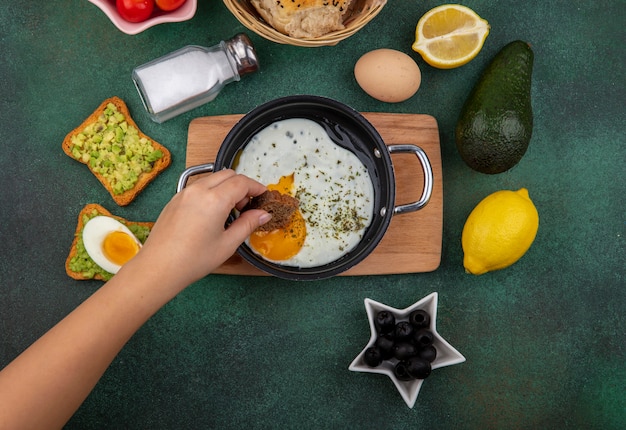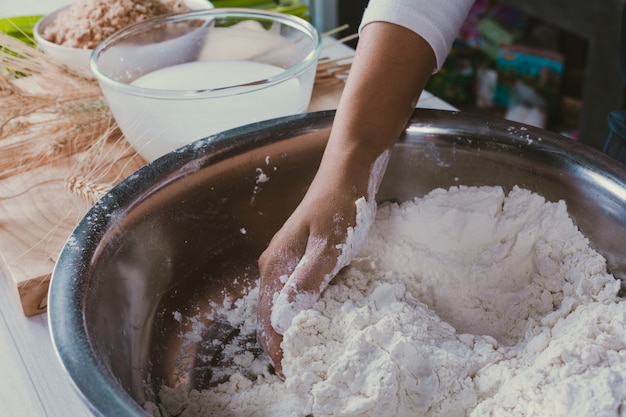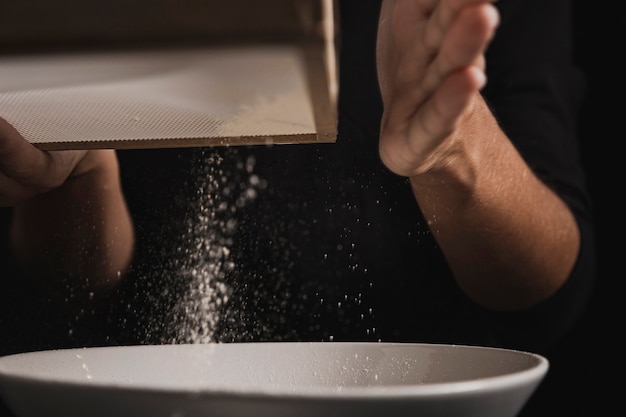Ah, rice. It's the ultimate comfort food, isn't it? A fluffy, fragrant bowl of rice can instantly transport you to a warm, cozy place, whether it's a bustling Asian street market or a quiet evening at home. But achieving that perfect texture, that delicate balance between fluffy and slightly sticky, can be a real challenge. I know, I've been there. Countless burnt pots, sticky messes, and dry, crumbly disasters have filled my kitchen with the ghosts of rice past. But fear not, my fellow rice enthusiasts, for I've finally cracked the code. Through years of trial and error, burnt pots and a few tears shed over a failed rice dish, I've learned the secrets to consistently perfect stovetop rice. And I'm sharing them with you today, because everyone deserves to experience the joy of a perfectly cooked bowl of rice.
This isn't just a recipe; it's a journey, a quest for rice nirvana. It's about understanding the nuances of rice cooking, embracing the simplicity of the process, and mastering the art of making each grain a fluffy, delicious delight. So, grab your favorite pot, gather your ingredients, and let's embark on this culinary adventure together.
(Part 1) The Rice: Choosing Your Perfect Grain

The first step in crafting the perfect stovetop rice is selecting the right grain. Rice comes in a bewildering array of varieties, each with its unique personality, texture, and purpose. choosing the right rice is crucial, as it will significantly impact the final outcome of your dish.
A Quick Guide to Common rice varieties
Let's break down the most common rice varieties and their ideal applications. It's like choosing the right tool for the job – the right rice will make all the difference.
- long grain rice: Think of this as the versatile workhorse of the rice world. Its long, slender grains lend themselves to a fluffy, separate texture, making it perfect for everyday dishes like stir-fries, fried rice, and rice bowls. It's the kind of rice that holds its shape well, even when mixed with other ingredients. The classic American long grain is a great starting point for most rice dishes.
- medium grain rice: This rice is a bit shorter and rounder than its long-grain cousin, resulting in a slightly stickier texture. It's a dream for sushi and rice pilafs, where its ability to hold its shape and provide a slightly chewier bite is key. It also makes a lovely addition to rice dishes that require a touch of richness and complexity.
- short grain rice: These plump, short grains are all about stickiness, making them the perfect choice for rice porridge, rice pudding, and those irresistible sticky rice dishes like mochi. They’re also perfect for recipes that require a creamy, almost pudding-like texture.
- brown rice: This whole grain rice is a powerhouse of nutrition and flavour. It boasts a nutty, earthy flavour and a chewier texture, adding a satisfying bite to any dish. The downside? It takes longer to cook than white rice. But the health benefits and the delicious flavour make it well worth the extra time.
- wild rice: While not technically rice, wild rice is a type of grass with a distinct earthy flavour and a slightly chewy texture. It's often used in salads or as a side dish, adding a unique dimension to the plate.
As you explore different rice varieties, you'll discover a world of flavors and textures waiting to be explored. Don't be afraid to experiment and find the rice that best suits your taste and culinary adventures.
(Part 2) The Water: Your Rice's Liquid Lifeline

Imagine water as the lifeblood of your rice. It's what brings the rice to life, infusing it with flavour and transforming those dry grains into a fluffy, delicious meal. Getting the water-to-rice ratio just right is crucial for achieving that perfect texture, that delicate balance between fluffy and slightly sticky.
The Golden Ratio
For most rice varieties, the general rule of thumb is a 1:2 ratio of rice to water. This means for every cup of rice, you'll use two cups of water. It's a simple equation, but it's the foundation upon which perfect rice is built.
Factors That Affect the Water Ratio
However, the water-to-rice ratio isn't a one-size-fits-all equation. It's more like a compass, guiding you towards the perfect balance. Several factors can influence how much water you'll need, and understanding them will help you adjust accordingly.
- Type of Rice: long-grain rice, with its slender grains, typically requires more water than short-grain rice, which has a plumper, more compact shape. The longer grains need more moisture to cook evenly.
- Altitude: Water boils at a lower temperature at higher altitudes. This means it takes longer for the rice to cook, and you might need to add a bit more water to compensate.
- Pot Size: A larger pot will have a slightly wider surface area for the water to evaporate from. You might need to add a tiny bit more water to prevent the rice from drying out before it's fully cooked.
- Personal Preference: This is the beauty of cooking: it's a personal journey. Some people prefer their rice a bit softer, while others prefer it firm and slightly al dente. Experiment with the water ratio to find the texture that suits your taste buds.
Don't be afraid to deviate from the golden ratio – embrace the flexibility and adjust the water to find the perfect balance for your rice.
(Part 3) The Pot: Your Rice's Culinary Stage

The pot is your rice's stage, the vessel that will nurture and transform the grains. While any pot will technically do, some are better suited for the job than others.
Choosing the Right Pot
Here's what to look for in a rice-friendly pot, a pot that will help you create culinary magic:
- Heavy-Bottomed: A heavy bottom is your rice's best friend. It helps distribute heat evenly, preventing hot spots that can lead to unevenly cooked rice. Think of it as a gentle embrace, ensuring that every grain gets the same amount of heat.
- Evenly-Sized: A pot that's too small can lead to overcrowding, resulting in uneven cooking and potentially sticking. A pot that's too large can leave the rice drying out before it's fully cooked. Find that sweet spot where the rice has enough room to breathe and cook evenly.
- Lid with a Steam Vent: This is essential for allowing steam to escape, preventing the rice from becoming mushy. The steam vent acts as a safety valve, ensuring that the rice cooks perfectly without becoming overly soggy.
It's worth investing in a pot specifically designed for rice cooking. They often come with features like a built-in steamer basket, which can be helpful for preparing other dishes while your rice cooks.
Prepping Your Pot
Before you begin, give your pot a good wash. This will ensure that there's no residue that could affect the flavour or texture of your rice. A clean pot is a happy pot, ready to welcome your rice and create a culinary masterpiece.
(Part 4) The Ritual: The Art of Stovetop Rice Cooking
Now that you've chosen your rice, measured your water, and prepped your pot, it's time to dive into the ritual of stovetop rice cooking. It's a simple process, but it requires a touch of attention and care.
Step 1: Rinse the Rice
This is an essential step, even if you're using pre-washed rice. Rinsing removes excess starch, which can make the rice sticky and clumpy, giving it that undesirable gummy texture. A thorough rinse ensures fluffy, separate grains.
- Place the rice in a fine-mesh sieve.
- Hold the sieve under running cold water. Gently swish the rice around until the water runs clear, indicating that the excess starch has been removed.
- Drain the rice and set it aside.
Step 2: Bring the Water to a Boil
This is where the magic begins. The boiling water will create the steam that will cook the rice perfectly, infusing it with flavour and transforming it into a delicious meal.
- Place the pot on the stovetop.
- Pour the water into the pot.
- Bring the water to a rolling boil over medium heat. The water should be bubbling vigorously, indicating that it's hot enough to start cooking the rice.
Step 3: Add the Rice and Seasonings
Once the water is boiling, it's time to introduce the rice and any seasonings you desire.
- Add the rinsed rice to the boiling water. The rice should gently sizzle as it hits the boiling water.
- Stir the rice gently with a fork or wooden spoon. This helps prevent the rice from sticking to the bottom of the pot and ensures even cooking.
- Add any desired seasonings. This could be salt, a pinch of sugar, or even a bay leaf for added flavour. A touch of seasoning elevates the rice, enhancing its natural flavors.
Step 4: Reduce Heat and Simmer
Now it's time to let the rice cook slowly and gently, allowing the steam to work its magic. Patience is key here, my friends.
- Reduce the heat to low. The goal is to achieve a gentle simmer, not a rolling boil. You want the water to bubble gently, releasing steam without vigorously boiling.
- Cover the pot tightly with a lid. This creates a steamy environment, allowing the rice to cook evenly and absorb the water.
- Simmer for 15-20 minutes, or until the rice is tender and has absorbed most of the water. You can check the rice by carefully lifting the lid and peeking inside. If the rice has absorbed most of the water, it's a good indication that it's nearly done.
Step 5: Rest and Fluff
After simmering, it's essential to let the rice rest and absorb the remaining moisture. This allows the grains to plump up and become perfectly fluffy, a symphony of texture and flavor.
- Remove the pot from the heat.
- Let the rice rest for 10-15 minutes, covered. This allows the rice to absorb any remaining moisture and continue to cook gently.
- Fluff the rice with a fork or a rice paddle. This helps to separate the grains and create that light, airy texture that makes perfect rice so irresistible.
(Part 5) The Secrets of Perfect Rice: Tips and Tricks
Over the years, I've picked up a few tricks of the trade that have helped me achieve consistently perfect rice. These tips aren't just for beginners; even experienced cooks can learn a thing or two.
1. Don't Stir Too Much
Stiring the rice too much can break up the grains, resulting in a mushy texture. Once the rice is added to the boiling water, give it a gentle stir to prevent sticking and then leave it alone. Let the steam work its magic, gently cooking the rice to perfection.
2. Watch the Steam
Keep an eye on the steam coming from the pot. When the steam starts to lessen, it means the rice is nearing the end of its cooking time. The steam is a visual cue, a sign that the rice is absorbing the moisture and nearing the end of its transformation.
3. Use the "Finger Test"
When the rice is nearly done, carefully lift the lid and peek inside. If the rice has absorbed most of the water, take a small amount of rice and press it between your fingers. It should be tender and slightly sticky but not mushy. This finger test is a quick and reliable way to gauge the rice's doneness.
4. Adjust the Water for different rice types
Remember, the 1:2 ratio is a starting point. Long grain rice might need slightly more water to achieve that fluffy texture, while short grain rice might need slightly less to achieve that desired stickiness.
(Part 6) The Experiment: Beyond the Basics
Once you've mastered the basics, it's time to explore the vast and exciting world of rice. Experiment with different flavors, techniques, and rice varieties to create your own unique culinary masterpieces.
Flavour Twists
Spice things up by adding your favourite seasonings to the rice as it cooks. A pinch of turmeric will add a vibrant yellow colour and a hint of earthy flavour. A bay leaf will infuse the rice with a subtle herbal aroma. A pinch of saffron will give the rice a luxurious golden colour and a delicate floral flavour. Experiment with different herbs and spices to create a symphony of tastes and aromas.
Cooking Methods
If you're feeling adventurous, try alternative cooking methods. The "absorption method" involves cooking the rice in a covered pot without stirring. This method results in a slightly drier rice, perfect for certain dishes. The "pressure cooker" method cooks rice quickly and efficiently, ideal for those short on time.
Rice Varieties
Don't be afraid to step outside your comfort zone and try different types of rice. Brown rice, wild rice, and black rice offer unique flavors and textures, adding a whole new dimension to your culinary repertoire.
(Part 7) The Transformation: Rice in Every Meal
Once you've perfected the art of stovetop rice, you'll discover it's not just a side dish; it's a blank canvas, a culinary base for endless possibilities, a versatile ingredient that transforms from humble grain to culinary star.
Breakfast
Start your day with a satisfying bowl of rice porridge, topped with fresh fruit, nuts, and a drizzle of honey. Or try a rice breakfast bowl with scrambled eggs, avocado, and your favourite toppings. Rice is a surprisingly satisfying breakfast option, providing energy and a slow-burning source of carbs.
Lunch
Pack a healthy lunch with a rice salad, loaded with vegetables, beans, and a light dressing. Or create a delicious rice bowl with your favourite proteins, vegetables, and sauces. Rice is the perfect base for a quick and easy lunch, offering a satisfying mix of textures and flavors.
Dinner
Rice is the perfect companion for any dinner. Pair it with roasted vegetables, grilled chicken or fish, or a hearty stew. Rice is a classic side dish, enhancing the flavors of any main course.
Snacks
Rice cakes make a healthy and satisfying snack. Top them with nut butter, avocado, or your favourite toppings. Rice cakes are a low-calorie snack option, perfect for a quick energy boost.
(Part 8) The Legacy: Sharing the Joy of Rice
Once you've mastered the art of stovetop rice, share your newfound knowledge with friends and family. Pass on the secrets you've learned, encourage them to embrace the simplicity of this timeless dish, and let them discover the joy of perfectly cooked rice.
Making rice on the stovetop might seem like a simple task, but it's a journey of discovery. It's about understanding the nuances of this humble grain, appreciating the beauty of a well-executed dish, and enjoying the satisfaction of creating something delicious and comforting from scratch. It's about embracing the process, from selecting the right rice to the gentle simmering, and ultimately, creating a dish that brings joy to your table.
FAQs
1. What if my rice is too sticky?
If your rice is too sticky, you likely used too much water or didn't rinse the rice adequately. Next time, use a bit less water and make sure to rinse the rice thoroughly until the water runs clear.
2. What if my rice is too dry?
If your rice is too dry, you likely didn't use enough water. Try adding a bit more water next time and simmering for a few more minutes.
3. Can I cook rice in a microwave?
Yes, you can cook rice in the microwave. There are special microwave-safe rice cookers available, or you can use a microwave-safe bowl with a lid. Follow the instructions on the rice package for microwave cooking times.
4. How do I store leftover rice?
Store leftover rice in an airtight container in the refrigerator for up to 3 days. To reheat, microwave the rice until it's hot and steamy.
5. Can I use different types of water for cooking rice?
You can use tap water, filtered water, or even bottled water to cook rice. The type of water won't affect the taste or texture of the rice significantly.
As you embark on your rice-cooking adventures, remember that there's no right or wrong way to do it. Experiment, find what works for you, and embrace the journey. And most importantly, enjoy the process! The joy of perfectly cooked rice is a journey worth taking.
Everyone is watching

Prime Rib Roast Cooking Time Chart: Per Pound Guide
Cooking TipsPrime rib roast. Just the name conjures images of lavish dinners, crackling fires, and hearty laughter. It’s ...

How Long to Bake Potatoes in the Oven (Perfect Every Time)
Cooking TipsBaked potatoes are a staple in my kitchen. They're incredibly versatile, delicious, and surprisingly easy to m...

Perfect Rice Every Time: The Ultimate Guide to Cooking Rice
Cooking TipsAs a self-proclaimed foodie, I've always been a bit obsessed with rice. It's the foundation of countless cuisi...

The Ultimate Guide to Cooking Asparagus: Tips, Techniques, and Recipes
Cooking TipsAsparagus. The mere mention of this spring delicacy conjures up images of vibrant green spears, crisp and burs...

Ultimate Guide to Cooking the Perfect Thanksgiving Turkey
Cooking TipsThanksgiving. Just the word conjures up images of overflowing tables laden with delicious food, the scent of r...
